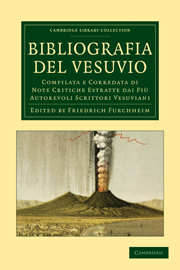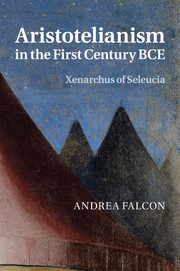Refine search
Actions for selected content:
10306 results in History of science: general interest
Erling Norrby, Nobel Prizes and Life Sciences. London and Singapore: World Scientific Press, 2010. Pp. xvi+317. ISBN 978-981-4299-37-4. £25.00 (paperback).
-
- Journal:
- The British Journal for the History of Science / Volume 45 / Issue 1 / March 2012
- Published online by Cambridge University Press:
- 27 February 2012, pp. 142-143
- Print publication:
- March 2012
-
- Article
- Export citation
Calvin B. Kendall and Faith Wallis (trans.), Bede: On the Nature of Things and On Times. Translated Texts for Historians 56. Liverpool: Liverpool University Press, 2010. Pp. xiv+222. ISBN 978-1-8463-496-4. £16.99 (paperback).
-
- Journal:
- The British Journal for the History of Science / Volume 45 / Issue 1 / March 2012
- Published online by Cambridge University Press:
- 27 February 2012, pp. 125-126
- Print publication:
- March 2012
-
- Article
- Export citation
BJH volume 45 issue 1 Cover and Front matter
-
- Journal:
- The British Journal for the History of Science / Volume 45 / Issue 1 / March 2012
- Published online by Cambridge University Press:
- 27 February 2012, pp. f1-f2
- Print publication:
- March 2012
-
- Article
-
- You have access
- Export citation
Justin E.H. Smith, Divine Machines: Leibniz and the Sciences of Life. Princeton and Oxford: Princeton University Press, 2011. Pp. xii+380. ISBN 978-0-691-478-7. £30.95 (hardback).
-
- Journal:
- The British Journal for the History of Science / Volume 45 / Issue 1 / March 2012
- Published online by Cambridge University Press:
- 27 February 2012, pp. 131-132
- Print publication:
- March 2012
-
- Article
- Export citation
David N. Livingstone and Charles W.J. Withers (eds.), Geographies of Nineteenth-Century Science. London and Chicago: The University of Chicago Press, 2011. Pp. x+526. ISBN 978-0-226-48726-7. £35.50 (hardback)
-
- Journal:
- The British Journal for the History of Science / Volume 45 / Issue 1 / March 2012
- Published online by Cambridge University Press:
- 27 February 2012, pp. 136-138
- Print publication:
- March 2012
-
- Article
- Export citation
Rebecca Messbarger, The Lady Anatomist: The Life and Work of Anna Morandi Manzolini. Chicago and London: The University of Chicago Press, 2010. Pp. xiv+234. ISBN 978-0-226-52081-0. £35.00 (hardback).
-
- Journal:
- The British Journal for the History of Science / Volume 45 / Issue 1 / March 2012
- Published online by Cambridge University Press:
- 27 February 2012, pp. 132-133
- Print publication:
- March 2012
-
- Article
- Export citation
John Bender and Michael Marrinan, The Culture of Diagram. Stanford: Stanford University Press, 2010. Pp. xx+264. ISBN 978-0-8047-4504-8. $60.00 (hardback).
-
- Journal:
- The British Journal for the History of Science / Volume 45 / Issue 1 / March 2012
- Published online by Cambridge University Press:
- 27 February 2012, pp. 133-135
- Print publication:
- March 2012
-
- Article
- Export citation
Vanessa Heggie, A History of British Sports Medicine. Manchester and New York: Manchester University Press, 2011. Pp. x+222. ISBN 978-0-7190-8261-0. £60.00 (hardback).
-
- Journal:
- The British Journal for the History of Science / Volume 45 / Issue 1 / March 2012
- Published online by Cambridge University Press:
- 27 February 2012, pp. 141-142
- Print publication:
- March 2012
-
- Article
- Export citation
Anthropology, standardization and measurement: Rudolf Martin and anthropometric photography
-
- Journal:
- The British Journal for the History of Science / Volume 46 / Issue 3 / September 2013
- Published online by Cambridge University Press:
- 23 February 2012, pp. 487-516
- Print publication:
- September 2013
-
- Article
- Export citation
‘To mend the scheme of Providence’: Benjamin Franklin's electrical heterodoxy
-
- Journal:
- The British Journal for the History of Science / Volume 46 / Issue 2 / June 2013
- Published online by Cambridge University Press:
- 23 February 2012, pp. 179-197
- Print publication:
- June 2013
-
- Article
- Export citation
Replication, re-placing and naval science in comparative context, c.1868–1904†
-
- Journal:
- The British Journal for the History of Science / Volume 46 / Issue 1 / March 2013
- Published online by Cambridge University Press:
- 10 February 2012, pp. 1-21
- Print publication:
- March 2013
-
- Article
- Export citation

Bibliografia del Vesuvio
- Compilata e Corredata di Note Critiche Estratte dai Più Autorevoli Scrittori Vesuviani
-
- Published online:
- 05 February 2012
- Print publication:
- 23 June 2011
- First published in:
- 1897

Letters and Extracts from the Addresses and Occasional Writings of J. Beete Jukes, M.A., F.R.S., F.G.S.
-
- Published online:
- 05 February 2012
- Print publication:
- 11 May 2011
- First published in:
- 1871
Francis Bacon and the ‘vexations of art’: experimentation as intervention
-
- Journal:
- The British Journal for the History of Science / Volume 46 / Issue 4 / December 2013
- Published online by Cambridge University Press:
- 31 January 2012, pp. 551-599
- Print publication:
- December 2013
-
- Article
- Export citation

Meteorological Observations and Essays
-
- Published online:
- 05 January 2012
- Print publication:
- 02 June 2011
- First published in:
- 1793

Aristotelianism in the First Century BCE
- Xenarchus of Seleucia
-
- Published online:
- 05 January 2012
- Print publication:
- 15 December 2011
Contents
-
- Book:
- Aristotelianism in the First Century BCE
- Published online:
- 05 January 2012
- Print publication:
- 15 December 2011, pp vii-viii
-
- Chapter
- Export citation
Texts, translations, and notes
-
- Book:
- Aristotelianism in the First Century BCE
- Published online:
- 05 January 2012
- Print publication:
- 15 December 2011, pp 51-164
-
- Chapter
- Export citation
Acknowledgments
-
- Book:
- Aristotelianism in the First Century BCE
- Published online:
- 05 January 2012
- Print publication:
- 15 December 2011, pp ix-ix
-
- Chapter
- Export citation
Index of passages
-
- Book:
- Aristotelianism in the First Century BCE
- Published online:
- 05 January 2012
- Print publication:
- 15 December 2011, pp 222-226
-
- Chapter
- Export citation
